Best high airflow motorcycle jackets 2025
Published on: 21 July 2025
CLICK SUMMER MOTORCYCLE JACKETS TO SHOP WITH FREE UK NEXT DAY DELIVERY
The traditional ‘mesh motorcycle jacket’ has a poor rep., which might explain why, these days, the premium brands tend to avoid using the term.
As a concept, the mesh jacket has been around for years. They tended to be more popular in the southern part of Europe than in the northern part. And for obvious reasons. And because protective, motorcycle wear was not always considered 'de rigeur' in such places, mesh jackets were often quite flimsy affairs. Back then the outer fabrics weren't tested for abrasion, and they probably wouldn't have stood up to much because large areas of these jackets were given over to lightweight mesh panelling. In fact, in the trade they were known universally as ‘teabag’ jackets, in recognition of their expendability! These jackets came with shoulder and elbow armour, but that was probably the only positive thing you could say about them in terms of protection.
Over here in the UK people would sometimes buy these mesh jackets for overseas' trips, although not many we suspect would have realised the trade off involved in terms of protection.
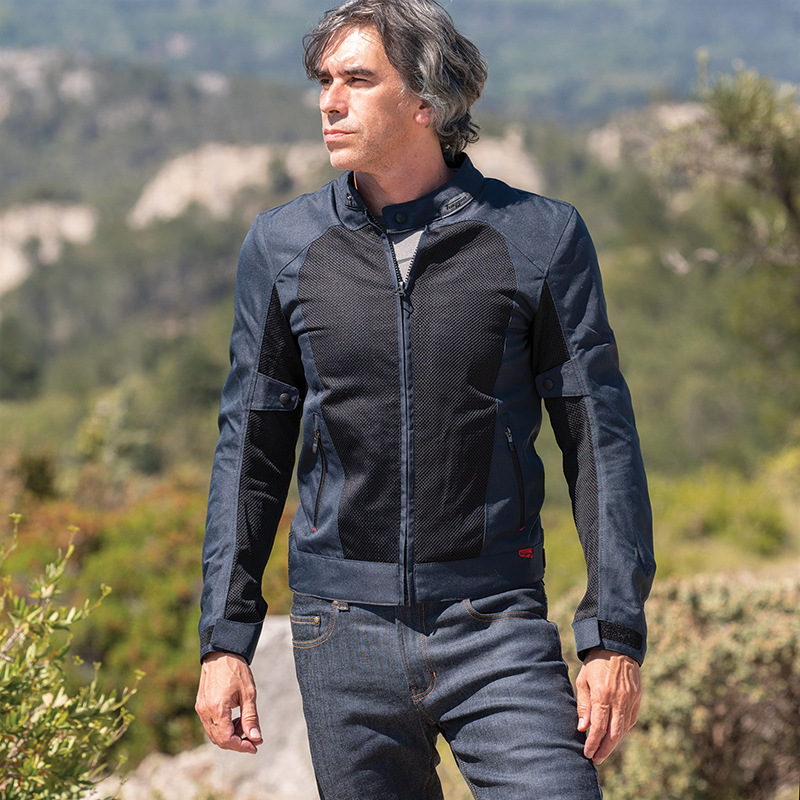
In fact, you can still buy this kind of mesh jacket today. They tend to be cheap as chips. And for pottering about on a super-warm day they are probably fine; and certainly better than riding around in a T-shirt. But the modern, high-airflow jacket that we're going to be talking about today is a very different kettle of poisson.
The kind of jackets we are talking about here are not as cheap as chips, but they are as protective as a regular motorcycle jacket; and in some cases somewhat more so. And whilst, for some, these jackets might be bought only to be used on balmy, high days and holidays, this is somewhat to miss the point.
And that point is that by layering inside and outside one of these jackets they can cope with almost every conceivable climactic condition; meaning that if you are looking for the one jacket that does everything, this type of jacket is perhaps the closest you're going to get.
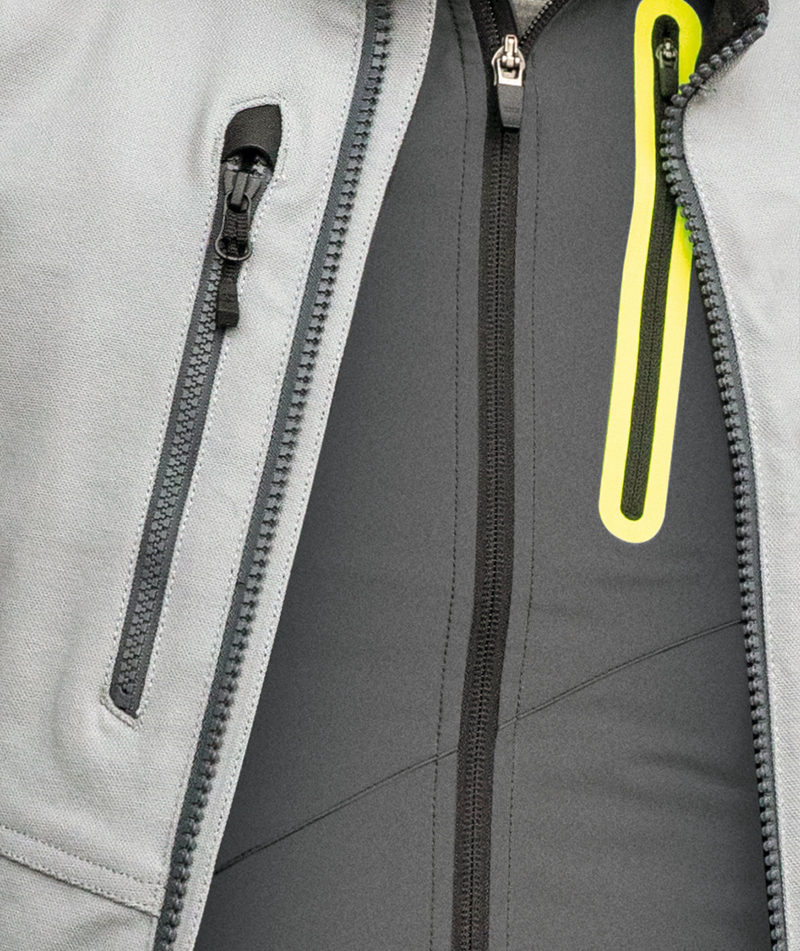
Layering with an airflow jacket
There is, of course, no such thing as the motorcycle jacket that will work in all weathers.
Nobody would ever imagine that they could pop into a clothing shop on the high street and buy themselves a coat that will serve them as well in the depths of winter as at the height of the summer. So why would anybody imagine that it's going to be different with a motorcycle jacket, where the demands on the body are so much greater?
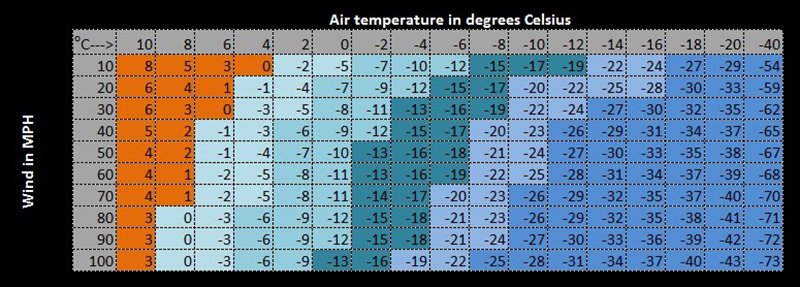
At 60 mph, moderate rain impacts the body with the force of a hurricane. And at 60 mph the body will perceive a four degree temperature as minus five. It's a similar story as far as heat is concerned. Walking in the park on a 30 degree day is one thing. Riding through a town centre on a 30 degree day sat on top of a scalding hot, internal combustion engine, when you're wearing a helmet and body armour is another.
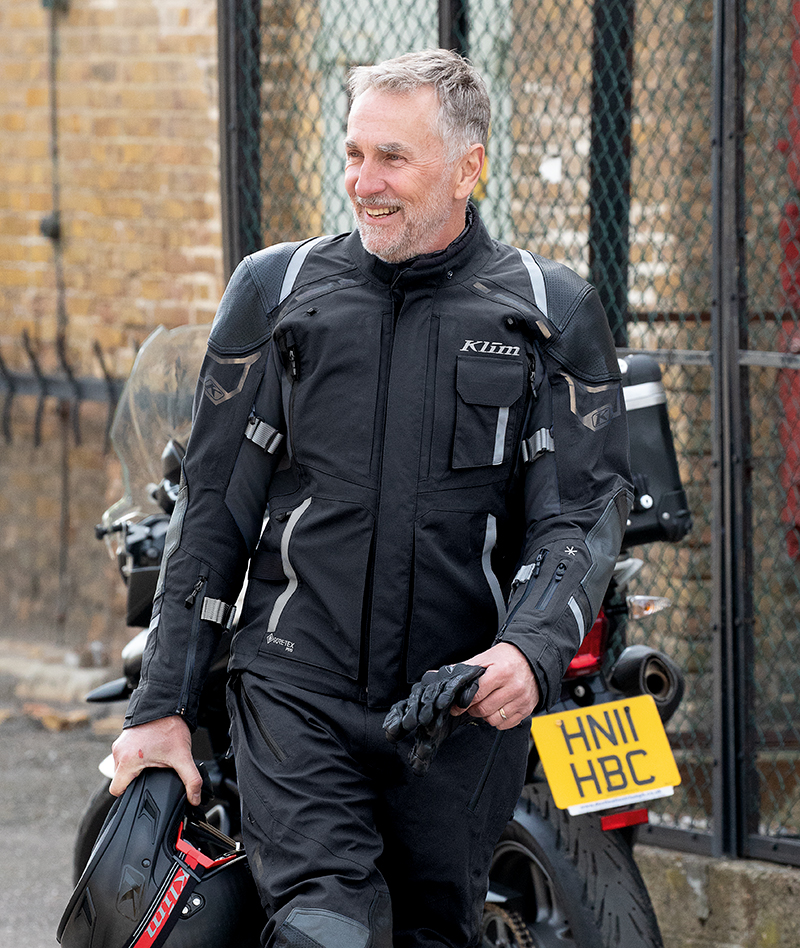
As we said there's no such thing as the jacket that does everything. Some try and convince themselves that if they spend enough money on a laminate jacket with lots of vents from somebody like Rukka or Klim they will get close to their desired nirvana. But that's poppycock. A laminate jacket may well keep you warm and dry, but once the mercury rises much above 20-25 degrees you'll start to wilt.
If you want a jacket that you really can wear all year round, and in all weathers, you will have to adopt the layering principle.
Now wearing a fleece below a kind of waterproof jacket does not, I’m afraid, constitute layering. For layering to work, the starting point has to be a highly breathable, protective outer jacket. You will then need to wear mid-layers below the jacket to help regulate your body temperature. And be prepared to put on a waterproof over the jacket to stay dry.
This is not as complicated as it sounds. But let us talk you through it, using Klim's Marrakesh to demonstrate the principles. In fact, throughout today's review we're going to use the Marrakesh as a benchmark; a jacket by which all the other jackets we are going to be discussing can be measured.
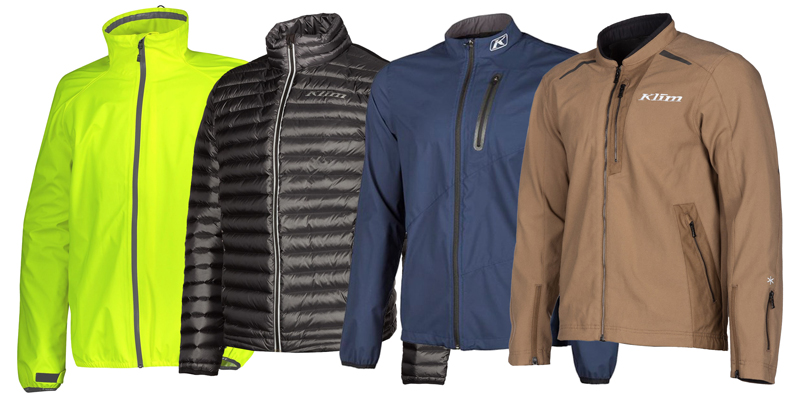
The perfect layering system
We like the Marrakesh. It's a brilliant jacket. It's comfortable, under-stated and more protective than one might imagine. But crucially the amount of stretch incorporated into the outer chassis makes it the perfect starting point for a layering approach.
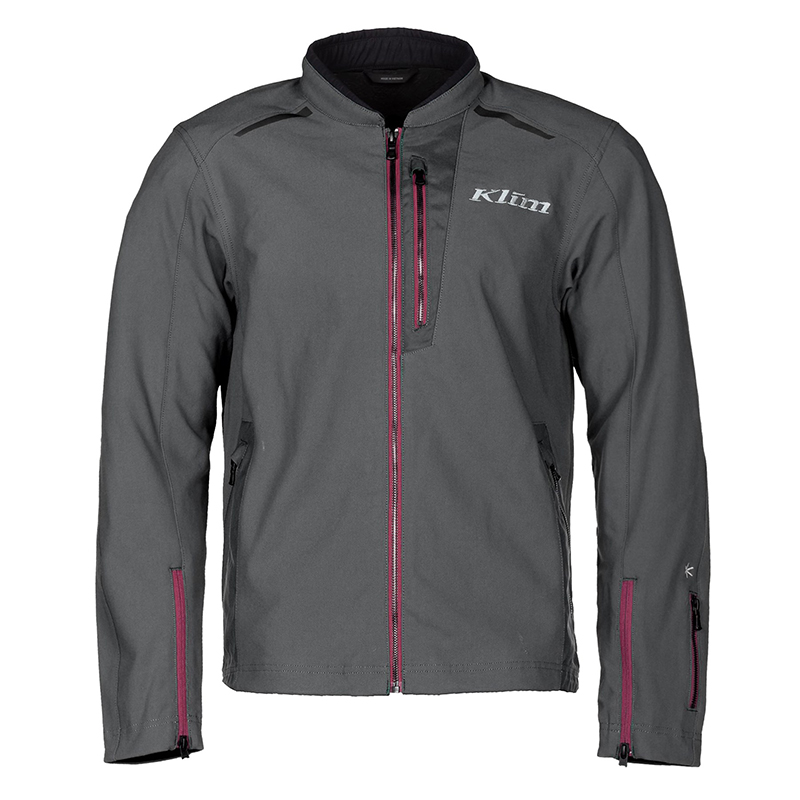
Like all the jackets we are going to be talking about today, it flows a lot of air. And it does so because its fabric is loosely woven in order to allow air to easily pass through it. Importantly, unlike a traditional mesh jacket, the air can flow through every single panel.
And so on a warmer day this is the kind of jacket you want to be wearing. When we get hot we need to be able to sweat effectively, which means that the sweat that comes to the surface of the skin needs to be able to escape into the ether and evaporate. This process, known as ‘evaporative cooling', is the body's way of regulating its temperature.

The other benefit of a high-airflow jacket in such conditions is that it will allow the oncoming air to reach the body, cooling the skin, thus reducing the body’s temperature, and the need to sweat in the first place.
High airflow jackets like the Marrakesh are nicest thing to wear on warmer days; by which we mean days where the temperature is from, say, eighteen degrees or above.
As the temperature drops we might want to wear something below the outer jacket to prevent us becoming too cold.
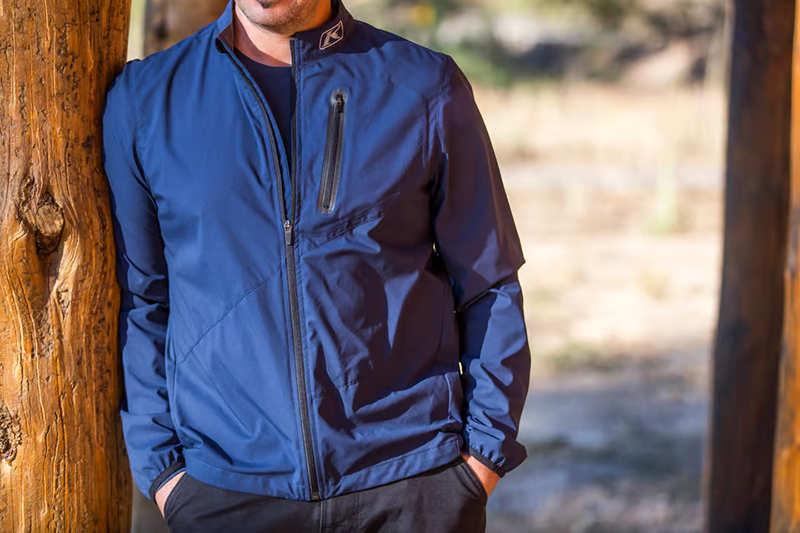
In our world, the first port of call would be something like the Klim Zephyr. This is a gossamer-thin, windproof layer that will reduce the impact of the incoming cooler air, and serve to insulate whatever heat is being generated by the body. Wear the Zephyr inside something like the Marrakesh, and you'll be able to ride comfortably down to a temperature of, say, 14 degrees or so.
Below that you are going to need extra help; something that is going to be better at trapping and insulating body heat. Now there are lots of mid-layers that will do such a job but, in our book, nothing does this better than a high-quality down jacket. Down contains a lot of air, and when this air is warmed up by heat from the body it holds on to it.
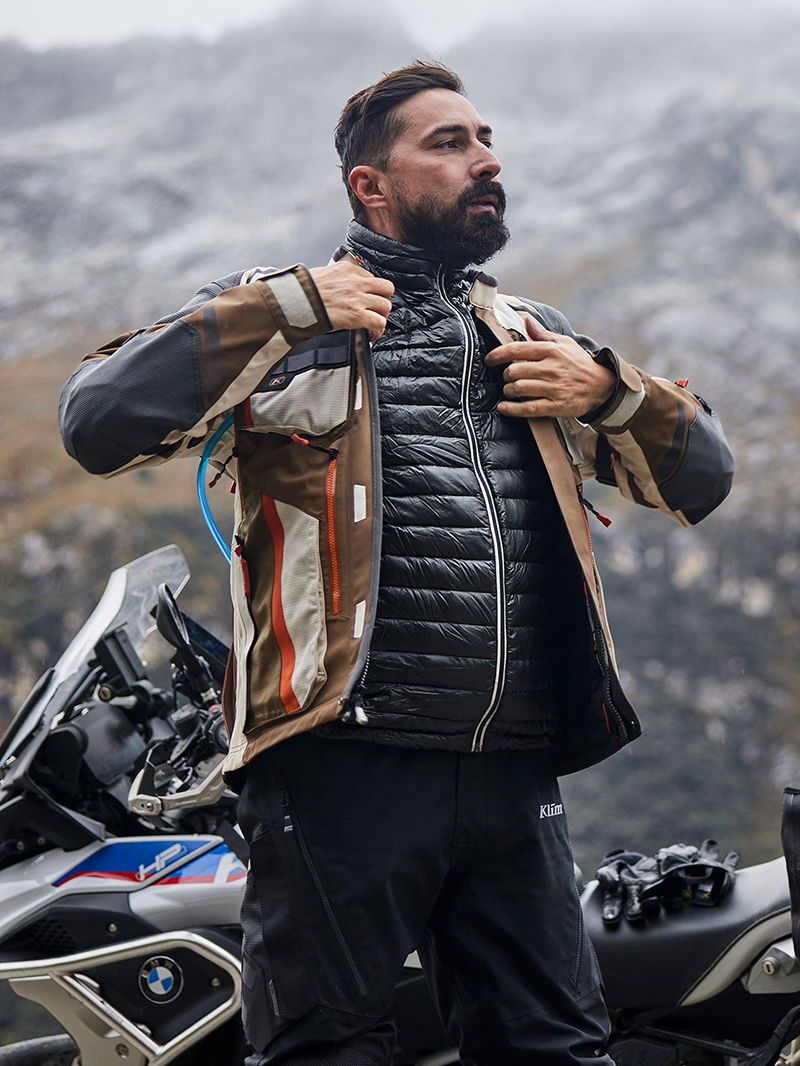
With a down jacket like the Klim Maverick below the Marrakesh, and preferably inside the Zephyr, you could easily ride down to mid, single-figure temperatures.
And so what we can see is how layering beneath a highly-breathable, protective jacket could allow you to ride comfortably in temperatures that most of us might be consider both pretty high and pretty low.
But what happens if it rains?
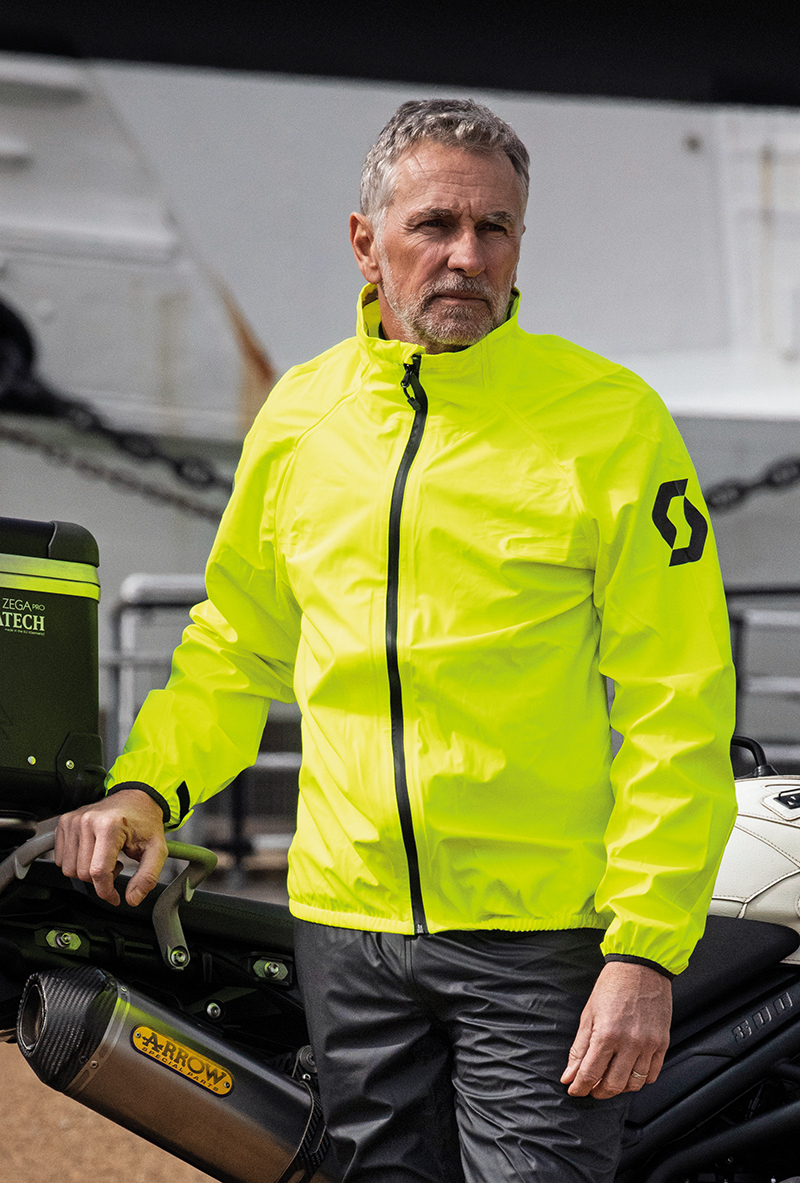
Well, with only insulating layers beneath a highly porous, outer jacket you're going to get wet if it rains. And so the last layer is a waterproof one that, per force, will go on over the protective layer. And of course this is the logical place for a waterproof layer to be.
Now most motorcycle jackets, for ease of construction and convenience, have a fixed, waterproof membrane inside the outer chassis. But no mountaineer, sailor or military man would ever put his waterproof layer on beneath his jumper or fleece. A waterproof layer rightly belongs on the outside to prevent the wet stuff finding its way into whatever it is you're wearing closer to the body. The fact is that a waterproof worn over a non-waterproof motorcycle jacket will deliver waterproofing levels superior to that of even a laminated jacket. And so a waterproof outer is the final layer. Put one on, ride for three hours in the rain, and when you reach your destination what is beneath it will still be bone dry.
Of course, this waterproof layer can perform another role. Basically, the fabric used in waterproof and windproof garments is very similar. And so when you don your waterproof you add a second windproof barrier that will serve to further protect you from the wind, and add further insulation.
And so this is layering.
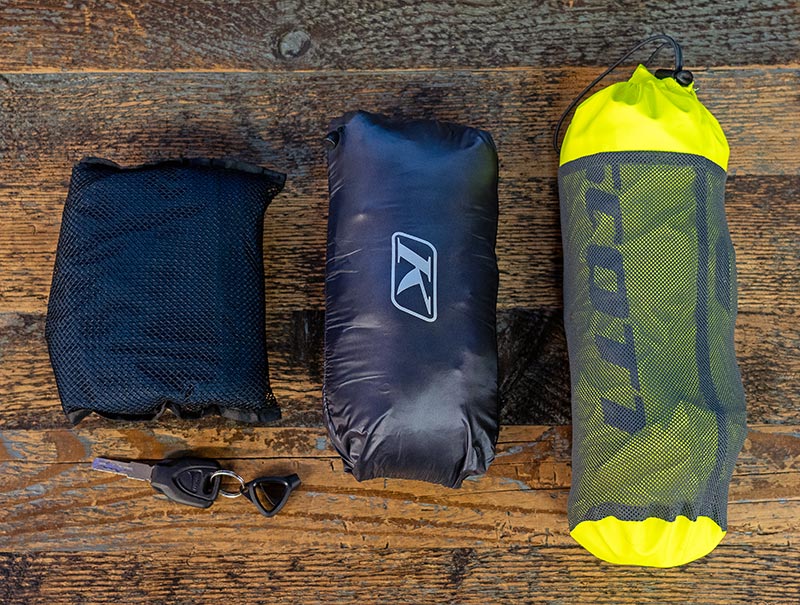
In our world, there's an outer layer with abrasion and impact resistant properties. There are then three little packages. A windproof, something like a down jacket and a waterproof. This is not the only way to layer; this is our way. But, as we have suggested, combine these three little bundles with a high-airflow jacket like the Marrakesh, and you can ride almost anywhere.
Anyway, what we're going to do now is look at a number of different, high-airflow jackets; all of which could be combined with layers in the way we have outlined.

The Halvarssons Arvika jacket
Truth be told, Halvarsson's Arvika jacket is not truly representative of this new breed of high-airflow jackets that we'll be talking about today. But we have incorporated it because it's certainly a notch above most traditional, mesh jackets.
The starting point is an AA rating for abrasion resistance, but when you combine this with Halvarssons' latest, large and highly breathable, Level 2 elbow and shoulder protectors you end up with a jacket that nobody need be concerned about riding in.
And with large areas of mesh down the front of the jacket, down the back and along the arms the Arvika is going to flow pretty decent amounts of air, although perhaps not quite as much as the other jackets we’ll be looking at.
The only issue from our perspective is that, coming from an older generation of jackets, the Arvika contains no stretch. And this means that it's not going to work as well as the other jackets we'll be discussing from a layering standpoint. That doesn't mean that it won't work; it just means it won't work quite as well.
The windproof Zephyr will be fine, but for colder conditions you might elect to go for the slightly less bulky Rukka Lahti rather than the Klim Maverick. Not quite as insulating perhaps, but enough for most scenarios, we might suggest. Obviously, there would be no issue with the Scott waterproofs.
But the reason we've included the Arvika is that, if the other jackets we are talking about today are a bit too punchy in terms of price, you might be glad to hear that the Arvika can be had for less than half the price of today’s other jackets.
Both the Klim and Rukka offerrings we'll be talking about are superior in many respects, but none comes close to offering the value for money of the Arvika.
There’s no matching pant for the Arvika. The nearest option from Halvarssons would be their Rogen jean, into which the Arvika will zip.
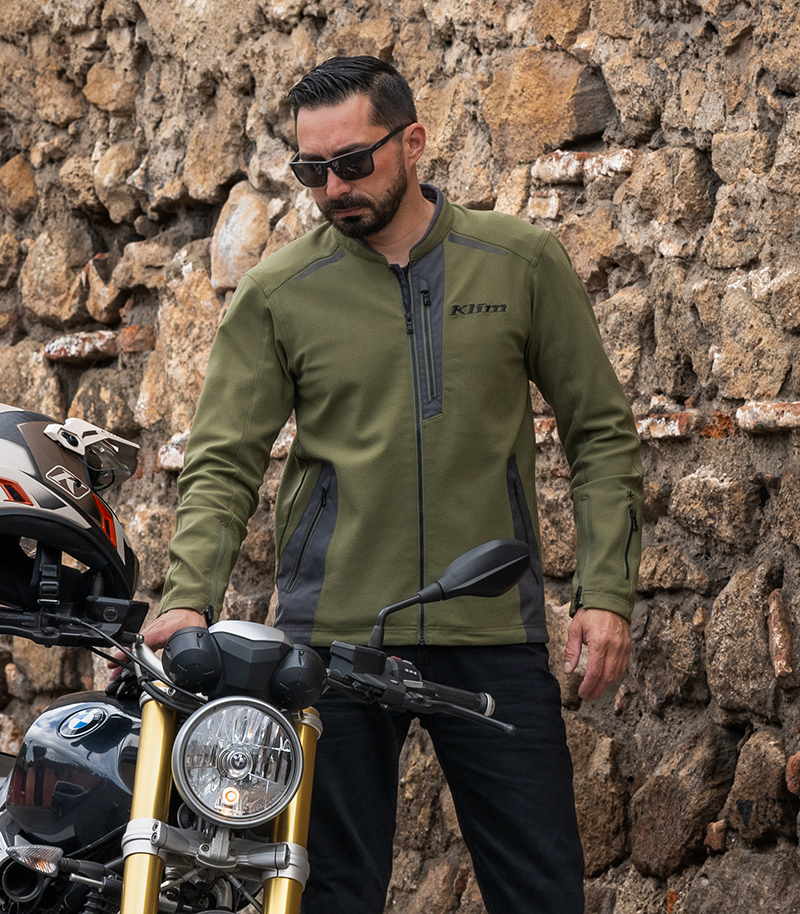
The Klim Marrakesh jacket
As I have intimated, for the purposes of today's discussion we'll be using the Marrakesh as the benchmark. We'll talk about the ways in which some of the jackets are better than the Marrakesh, and the ways in which some are not as good.
And this seems appropriate. For us it is the Marrakesh that introduced us to the benefits of layering; and even now we think the jacket potentially represents the best balance of qualities. As we have often said, it's our favourite motorcycle jacket. Not our favourite Klim jacket or our favourite airflow jacket. It's simply our favourite motorcycle jacket. Period!
Its USP is probably its comfort. The key element in the jacket's construction is a super-heavy weight, 1000 denier Cordura. We've never come across another motorcycle jacket that uses Cordura this strong. Now for comfort Klim has mixed in with the Cordura a lot of Elastane. This is what gives the jacket its unsurpassable level of comfort. Now when you add Elastane into a material you weaken it from an abrasion-resistance perspective but as, in this case, the starting point is such a heavy fabric Klim has still been able to deliver an AA abrasion resistance rating on the Marrakesh. And for something this easy to wear that's not unimpressive.
The Marrakesh comes with a full suite of D3O armour. It's Ghost armour which, until recently, set the bar in terms of wearability. But it's only Level 1; and given the new Level 2 Diablo armour from D3O we would upgrade to it in a heartbeat. Quite simply it offers more protection, more comfort, better positioning and much improved breathability. There's not yet a Level 2 Diablo back protector, so we would upgrade to the Rheon one.
As we have suggested it's the stretch component that causes the Marrakesh to stand out from the crowd. That makes it incredibly comfortable, but more importantly perhaps it allows layers to be accommodated without the wearer feeling encumbered. The Marrakesh is the stretchiest of all of the jackets well be discussing today.
The downside of the Marrakesh, and it's a criticism that we'll be levelling at all three of the Klim jackets we'll be discussing today, is that it comes in just six sizes. Sizes that are meant to accommodate everyone from the guy who always gets sand kicked into his face, right up to Giant Haystacks’ larger brother. And quite simply that's not enough sizes. It means that a lot of people fall between them. That's a great shame, but don't worry; if a Klim jacket doesn't work on you a Rukka one might well do.

What I have not mentioned yet is how much air the Marrakesh flows. Well in that every single panel flows air, it flows a lot, although we will be talking about jackets that flow more air. Now I have ridden overseas in my Marrakesh in temperatures exceeding 35 degrees, and was never minded to rip it off and run screaming into the bush. I even wore it in the Sahara where, having broken my ankle early in the morning, I spent most of the rest of the day lifting bike out of the sand. I was bleeding hot, but it never occurred to me to divest myself.
I have written elsewhere of the self-evident truth that if you offer a motorcyclist something that can be turned up to 11, he will want it. But you will have to ask yourself whether a jacket that flows more air than the Marrakesh is going to flow too much air for riding in the UK. It's just a question!
But all things considered for us the Marrakesh possesses the optimal blend of talents. It is rightly the benchmark in this arena.
There is a matching Marrakesh trouser, although it’s really only designed to go over an ankle boot. That having been said I did recently see a guy get them over a pair of Road Stars; albeit after a bit of a struggle!
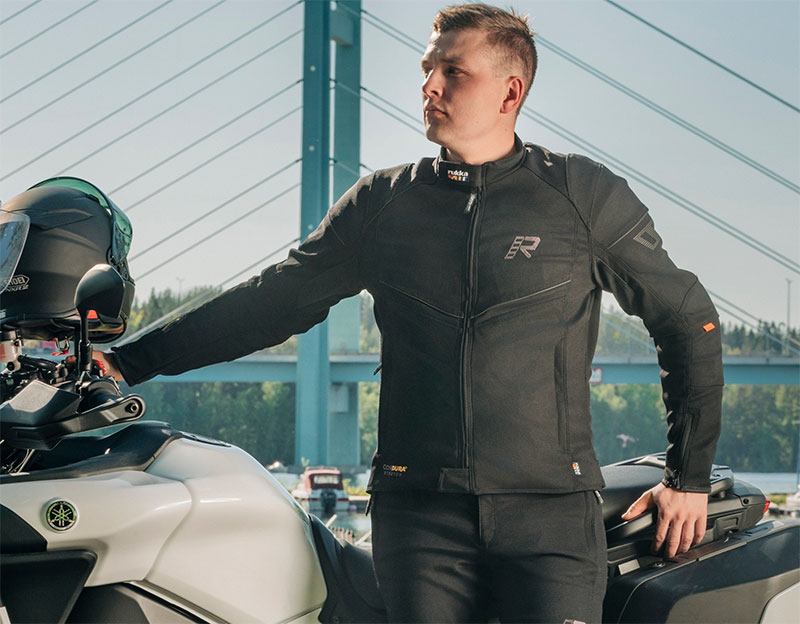
The Rukka Air Karvik jacket
The Rukka Air Karvik is a little dull-looking in this company. But then again it is a Rukka; a brand not renowned for its design flair and bold use of colours.
But being entirely black this will be the go-to jacket for all those die-hard, Rukka-wearing commuters who eventually come to the realisation that spending all that money on a laminated jacket doesn't guarantee four-season comfort! They will welcome the fact that the jacket is black, that it looks like every other Rukka jacket, that it has a big ‘R’ on the back and that it will zip into their existing pants.
In terms of airflow, we reckon there's not going to be much in it if you're comparing it to the Marrakesh. There was, a few years ago, a Rukka jacket called the Forsair. Now that jacket did flow more air than the Marrakesh; and that was because it was made using a special, knitted fabric that flowed 200% more air, (ie: three times as much), than an equivalent woven fabric. The Karvik, like the Rukka Vihti that we'll be discussing later, is woven, and not knitted!
Like the Marrakesh, the Karvik flows air through every panel. Now it starts off with a 500 denier Cordura thread rather than the Marrakesh's 1000 denier. It still passes the EN17092 abrasion test at the same AA level as the Marrakesh, and so what one can say with a degree of confidence is that the Karvik contains less stretch than the Marrakesh; and certainly that’s subjectively how it feels to us.
There are, though, a couple of things you get with Rukka’s jackets that you don’t get with Klim’s. First, Rukka’s jackets come in 11 sizes rather than six, meaning that you stand a better chance of getting that perfect fit. Second, both the Rukka jackets we’ll be talking about come with Rukka’s huge, bespoke, Level 2 D30. It’s D3O so it’s still comfortable, but the size and the CE rating of this armour means that you get much higher levels of abrasion resistance and impact protection than you will get from normal-sized D3O.
So there you have it. The Karvik will flow air similarly to the Marrakesh. The lack of stretch and the larger armour mean that it won’t be a match for the Marrakesh in terms of comfort. The Karvik is also not much of a looker. But the armour means that the Air Karvik will be more protective than the Marrakesh. And the number of sizes means that people who don’t work in a Marrakesh may well be able to find a perfect fit in it.
There is a matching pant for the Air Karvik; available in 11 sizes, and different leg lengths.
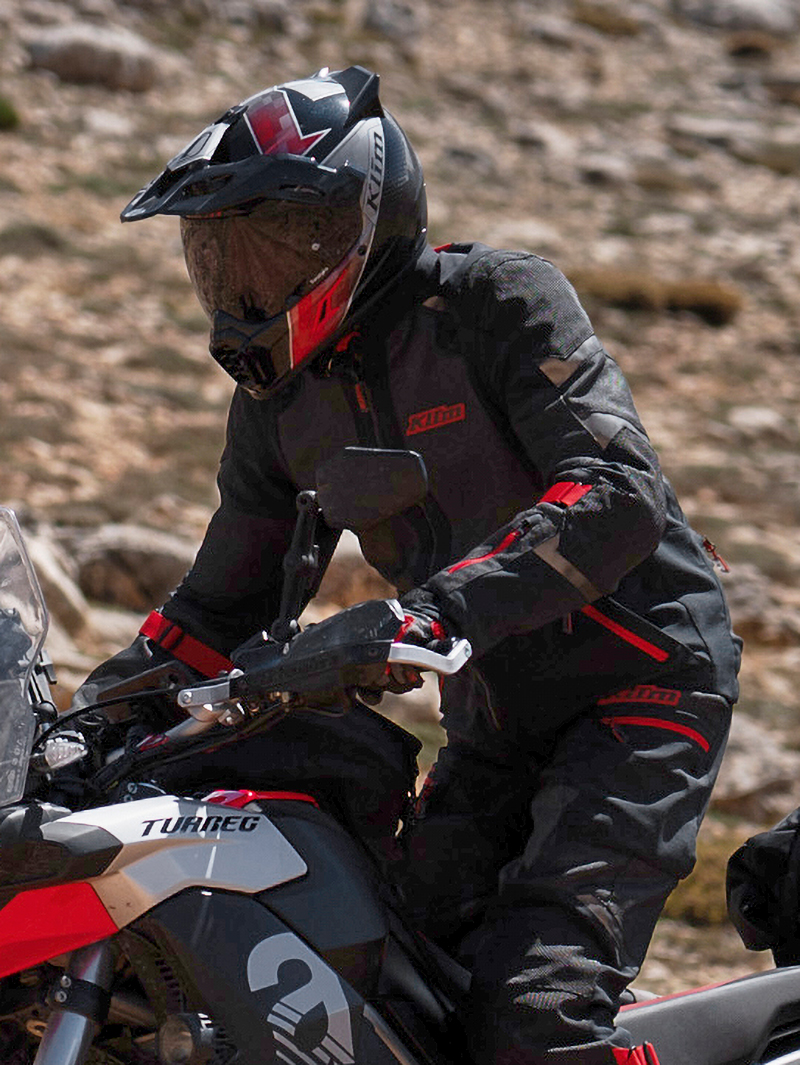
The Klim Baja S4 jacket
Klim classifies its motorcycle wear as either ‘road’ gear or ‘off-road’ gear. We will be talking about three Klim jackets today. Two of them are designated road suits. The Baja S4, though, is designed for the rough stuff.
There’s another suit in their range that in terms of airflow is very similar to the Baja. It’s called the Induction Pro. The key difference is fit; the Baja being boxier and baggier as befits the requirement for more mobility on the bike when you’re riding off-road.
Now no two ways about it, the Baja will flow more air than the Marrakesh. A reasonable proportion of the surface of the jacket is made from exactly the same fabric that the Marrakesh is made from. And this is where the Baja gets its comfort from. But a much larger part of the jacket is made from a micro-mesh fabric that flows a lot more air.
Klim has created the Baja for serious, off-road riding in the very warmest conditions. In their marketing bumf they talk about it being born for open deserts, towering sand dunes and humid jungles. And that sounds about right to us. And in such conditions you will need air to flow very freely, but it does raise the question as to whether the Baja S4 is going to flow too much air for a more pedestrian circumnavigation of the M25.
Now having said that the Baja S4 is designed for off-road riding, we often find that the fit will work fine on road riders As it’s slightly baggier that might just mean that it sometimes better fits those who have allowed their six packs to loose their hard edges.
But it’s really the pants that reveal the Baja’s off-road underpinnings. They are super wide in order to allow them to be worn over the very largest, off-road boots. So whilst the jacket may well work fine on the black stuff, the Baja pants don’t work as well when it comes to the road.
In terms of protection, the Baja jacket rates AA for abrasion resistance; and that’s fair enough; it’s probably all that one might need in an off-road suit. But in a very serious, off-road suit like this we would have expected Level 2 armour; and somewhat disappointingly the Baja comes with only Level 1 D3O. Now it’s proper shaped D3O, which is good, but if I were to undertake the kind of arduous riding that the Baja is designed for I would upgrade to Level 2, or wear a body armour vest like Rukka’s AFT vest.
That having been said, as far as hard riding in the dirt in the searing heat is concerned, there’s not much to compare with the Baja.
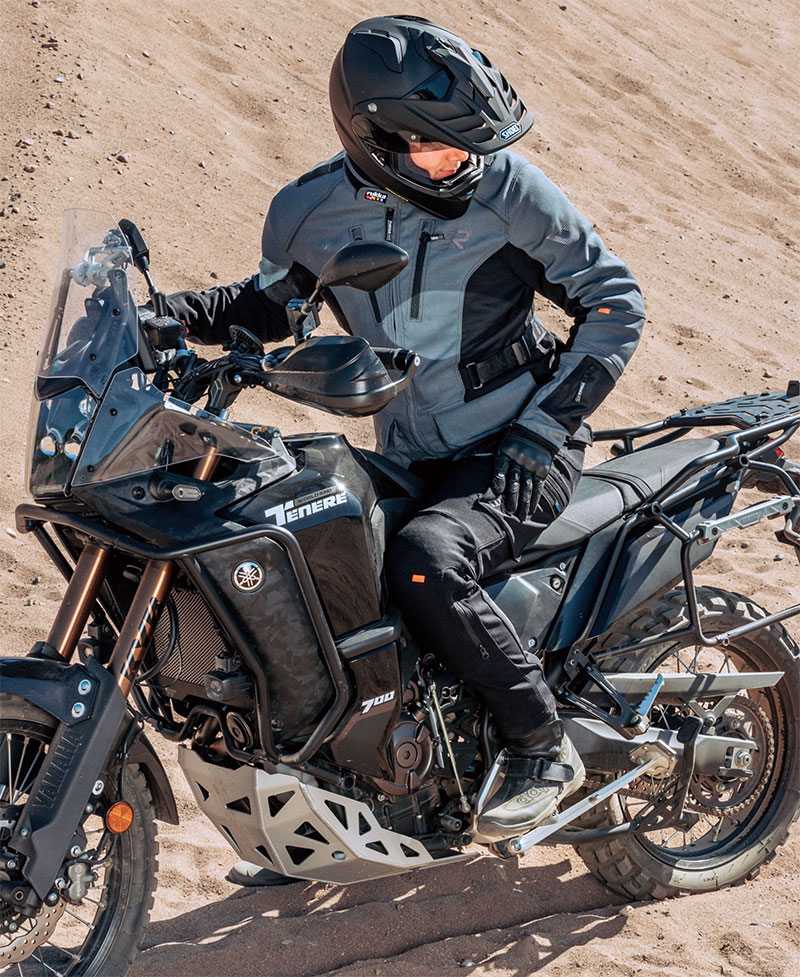
The Rukka Air Vihti jacket
The Vihti is a longer, more adventure-styled version of the Air Karvik jacket that we’ve already discussed. It will flow about the same amount of air as the Air Karvik; and that means about the same amount of air as the Marrakesh.
Like the Karvik, the Vihti is rated AA for abrasion resistance. As, with other Rukka jackets, it comes with the same, over-sized, Level 2, D3O armour making it, like the Karvik, the most protective of the jackets here. Like the Air Karvik, there’s no back protector as standard, but there are a number of possible options.
As with the Air Karvik, another advantage with this jacket is the number of sizes it’s available in; eleven as opposed to six.
But we prefer the Air Vihti to the Air Karvik for a couple of reasons.
First it comes in a very ‘how-dare-you’ grey. And even though that doesn’t signal a pushing out of the boat for most brands, it does improves the aesthetics. It gives the jacket a bit more of an adventure look but, importantly, if you’re journeying somewhere bloody hot you really don’t want an all-black jacket like the Air Karvik.
The second thing we like on the Air Vihti is the adjuster straps. We would have liked them even more if they were elasticated, but even so they allow you to enlarge or reduce the volume inside the jacket. In the Marrakesh that’s what the Elastane does, but side adjusters do the job equally well. And so we approve.
The bottom line? A longer, more adventure-styled jacket. Airflow is up there, although not class leading. The protection is the best once you add a back protector. And even though this is probaly less comfortable than most the jackets here, the adjusters mean that it is very well suited to layering. And with 11 sizes your chances of getting a good fit are strong.
The matching lower half for the Air Vihti is actually the Air Karvik pant.
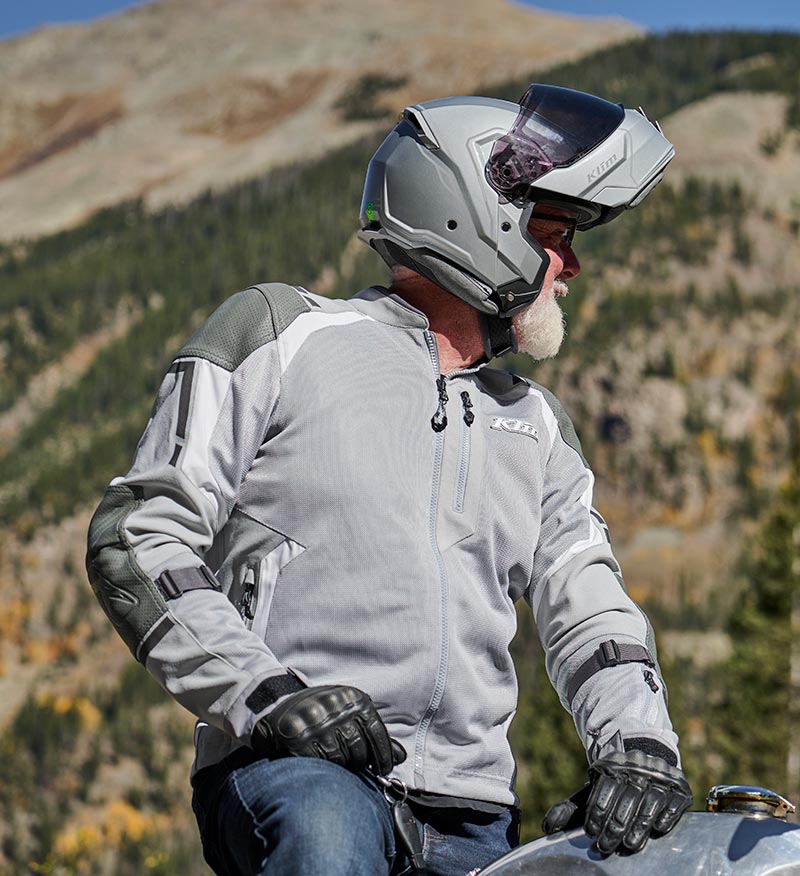
The Klim Induction Pro jacket
In terms of the way it’s constructed, the Induction Pro is very similar to the Baja S4. That is to say that it’s made from a combination of the stretchy, 1000 denier Cordura used on the Marrakesh and a micro-mesh material that flows even more air. The difference between the two jackets is that the Induction Pro is designed for road riding whereas the Baja is an off-road jacket. And what this means is that, in principle, the Induction Pro will fit a little more closely to the body than will the Baja.
But what the two have in common is that they were both designed for riding in the very hottest of conditions. Indeed, Klim themselves say that they made the Induction Pro for riders in states like Alabama, Georgia and Texas.
Which begs the question, once again, as to whether the Induction Pro flows too much air for the UK. And I think we would suggest that potentially it does. We often warn Marrakesh buyers of the need to put layers on as soon the sun disappears from the sky. Well if that’s the case with the Marrakesh, it’s far more so with the Induction Pro. Unless it’s a really warm day, you run the risk of getting cold in an Induction Pro. Not that this should be too much of a problem if you have a Zephyr and a Maverick. But you are going to need to don these somewhat earlier than you would do if you were wearing a Marrakesh.
Because part of the chassis of the Induction is made from the same material as the Marrakesh, it’s quite a stretchy jacket, and very comfortable; but on that score it’s still no Marrakesh. One of the other reasons it’s not quite so comfortable as the Marrakesh is that it comes fully kitted out with Level 2, D3O, whereas the Marrakesh itself comes with Level 1 Ghost. Now thicker and heavier armour will always impact on comfort, but the upside is more protection. And remember, Level 2 armour will deliver not just added impact protection, but added abrasion resistance as well.
What we don’t quite understand is why Klim put Level 2 in the Induction and Level 1 in the Baja. That seems wrong to us, as when you ride off-road impact protection is even more necessary. But it’s because of the higher rated armour that we have to say that we prefer the Induction to the Baja. The difference in fit is not huge; but for us the better armour makes it a bit of a no-brainer.
Of course, what one should not forget is that all the jackets we’re talking here about here have matching pants. If you do ride off-road, you may want to ride in a larger, off-road boot. And of course that may well mean that the Baja option is going to work better for you. But if you ride on the road, and wear something more like a Daytona Road Star, there is the slightly less flared Induction pant. But it’s not an Induction ‘Pro’ pant, so it only comes with Level 1 armour.
The bottom line here is that we really rate the Induction Pro jacket. It is probably not the right jacket for over here, but if you do travel to the southern part of Europe, if you want to ride in Morocco, or if you find yourself somewhere like Australia or India, then the Induction Pro may well be the jacket you want.
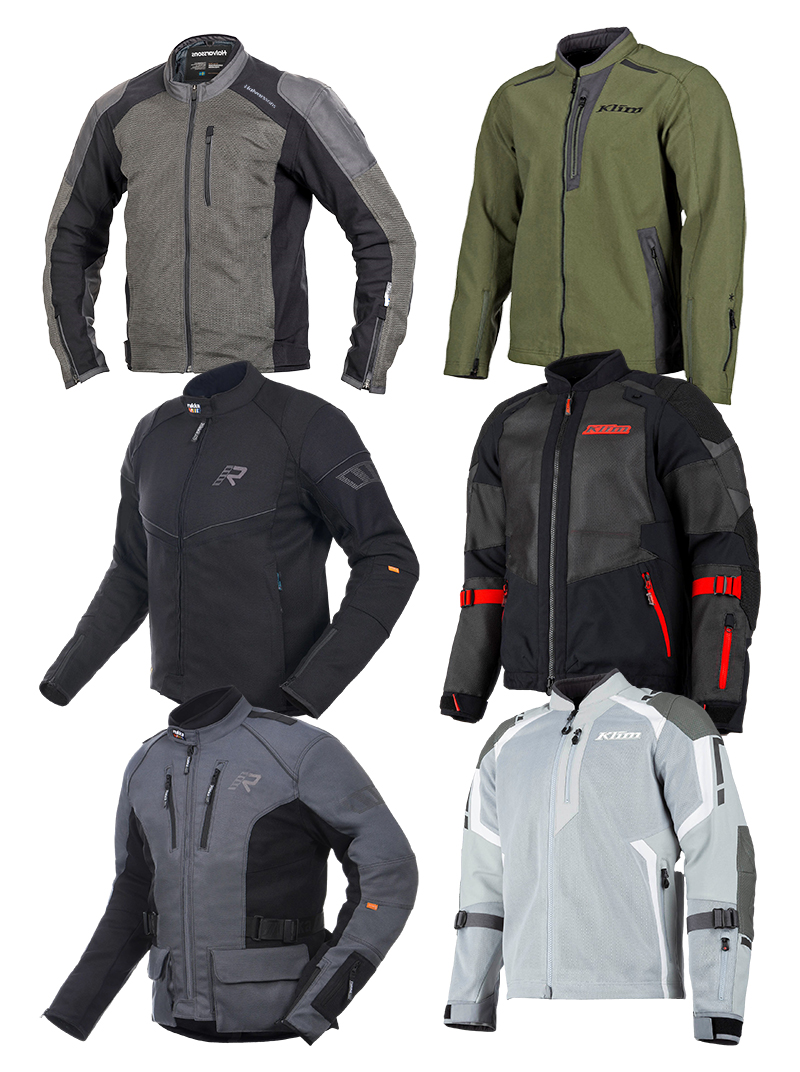
This is where we get to
We have today looked at six of the best airflow jackets out there.
I hesitate to call them mesh jackets because whilst in some ways that’s kind of what these jackets are, the term connotes, as I have intimated, those cheap and cheerful jackets of old that really weren’t up to much.
As ever, there’s no winner here. Each of the jackets we’ve looked at has its strengths and weaknesses.
The Arvika is, in truth, more akin to that older generation of jacket. But it is AA rated, and as with all new Halvarssons jackets, comes with great, Level 2 armour, so it’s not lacking in the protection department. In our book, it’s the affordable one. The best value one.
Both the Rukka jackets come in a lot more sizes, and are more protective, than any of the Klim ones, but the Air Karvik, whilst functional, is a bit dull. It’s probably perfect, though, for those who want to zip a more breathable jacket into their existing Rukka pants. The Air Vihti is more adventure in its styling. And we particularly like the waist adjusters that allow one to reduce or expand the internal volume to cater for layers.
The Baja and the Induction Pro both flow more air than any of the other jackets here. And potentially they both flow too much air for riding in the UK. We like the Level 2 armour in the Induction Pro, and don’t understand why the Baja only has Level 1. If we were riding off-road we would want to upgrade it. The choice of which of the two to go for might be dictated by the matching trousers, because the Baja pants will accommodate a larger boot better than the Induction pants.
Which brings us back to the Marrakesh.
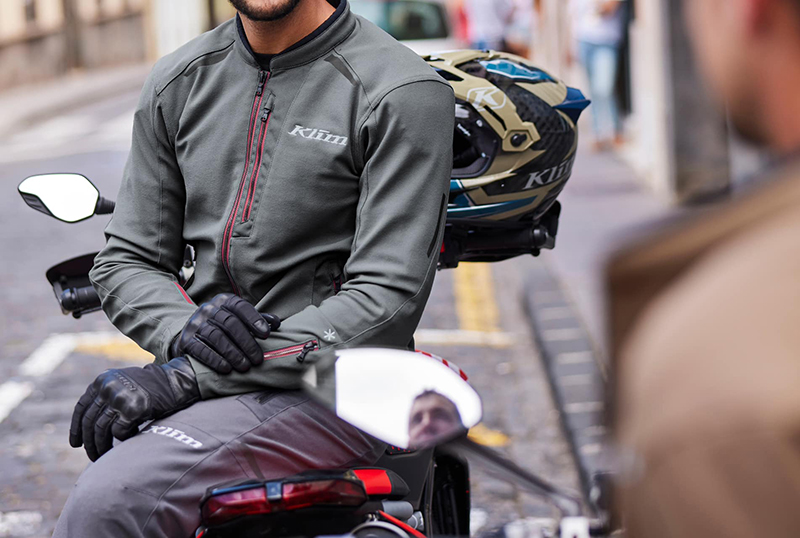
The Marrakesh is beaten by the other two Klim jackets when it comes to airflow; and by both Rukka jackets when it comes to protection. But the Marrakesh is more comfortable than them all. And it’s the stretch in the fabric that makes it so. Its stretchiness is also what makes it the best jacket when it comes to layering.
Somewhat subjectively, we also like the amount of air the Marrakesh flows. In our view it flows the perfect amount of air for riding over here. I have ridden in thirty five degrees in my Marrakesh, and never felt as though I was over heating. Yet you could still ride down to, say, 18 degrees with nothing beneath it, without freezing your nuts off in a way that probably wouldn’t be the case in the Induction Pro or Baja jackets.
All the jackets under discussion here are rated AA for abrasion resistance, but one cannot help but feel that the Marrakesh’s Level 1 Ghost makes it the weakling of the pack when it comes to protection. Upgrading to Level 2 Diablo would even the score up without any compromise on comfort. Do that and you would still be paying less than you would be for the either of the other Klim or the Rukka jackets.
Do that, and the Marrakesh would still get our vote!
You can buy summer motorcycle jackets with free next day UK delivery online, or visit our store in Guildford to try one on.
Share this story
































































